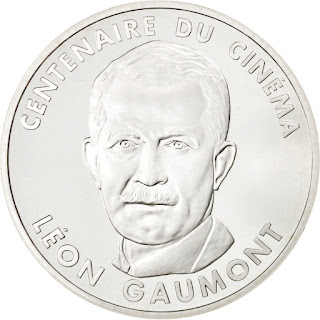France 100 Francs Silver Coin 1995 Leon Gaumont
Commemorative issue: 100th Anniversary of Cinema
Obverse: Léon Gaumont (1864 – 1946) was a French inventor, engineer, and industrialist who was a pioneer of the motion picture industry.
Lettering: CENTENAIRE DU CINÉMA LÉON GAUMONT.
Engraver: Atelier de Paris.
Reverse: Lumière Cinématographe Camera (Cinématographe Lumière at the Institut Lumière, France)
Lettering: LIBERTÉ ÉGALITÉ FRATERNITÉ RF 100 FRANCS 1995
Edge: Smooth.
Value: 100 Francs.
Metal: Silver (.900).
Weight: 22.2 g.
Diameter: 37 mm.
Thickness: 2.2 mm.
Shape: Round.
Commemorative coins of France
100th Anniversary of Cinema
Gerard Philipe Arletty Yves Montand Leon Gaumont
Léon Gaumont
Léon Gaumont (May 10, 1864 – August 9, 1946) was a French inventor, engineer, and industrialist who was a pioneer of the motion picture industry.
Léon Ernest Gaumont, born in Semblancay, Indre-et-Loire was gifted with a mechanical mind which led him to employment manufacturing precision instruments. From early childhood, he was fascinated by the technique of photography. When he was offered a job at the Comptoir géneral de photographie in 1893, he jumped at the opportunity. His decision proved fortunate when two years later he was given the chance to acquire the business. In August 1895, he partnered with the astronomer fr:Joseph Vallot, the famous engineer Gustave Eiffel, and the financier Alfred Besnier to make the purchase. Their business entity, called L. Gaumont et Cie, has survived in one form or another to become the world's oldest surviving film company extant. The company logo was the distinctive "Marguerite" (named after his mother), a type of flower similar to the daisy. The company had extensive studios (La Cite L'Elge) in the Buttes Chaumont District of Paris, and a smaller operation in Nice, France.
Léon Gaumont's company sold camera equipment and film, but in 1897 inaugurated a motion picture production business. Initially, Gaumont made films for the picture arcade business such as those operated by the Lumière brothers, but it was under the direction of Alice Guy (Gaumont's secretary - First Woman Film Director), that they began making short films based on narrative scripts. Louis Feuillade (Judex, Les Vampires, Fantomas) was to follow as the Studio Director when Guy left for Fort, Lee, New Jersey, where she subsequently opened her own production company—Solax Films) and it was then that Gaumont rapidly expanded the business into cinematographic equipment for amateurs. Within a few years, Gaumont's company ranked second only to Pathé Frères in the field of French Cinema. In 1903, Gaumont was granted patents for his Chronophonographe and loudspeaker system designed to work with his sound-on-disc talking pictures: the chronophone. The Etablissements Gaumont was founded in 1906 to handle film production and distribution plus to build a chain of movie theaters including the giant Gaumont Palace (Place Clichy - former "Hippodrome) in Paris (largest in the world at the time). By 1910 Léon Gaumont had improved his synchronous sound invention to the point where he was able to provide enough volume for up to 4000 people in a theater. In 1912, Gaumont developed a color process for film.
One of the two dominant forces in film in all of Europe, World War I profoundly affected Leon Gaumont's business fortunes (over 300 employees were drafted, Nitrate Emulsion film stocks dwindled because of the need for nitro-cellulous in the munitions industry); nevertheless, before retiring in 1930, he had built one of the most important film companies in cinema history.
Upon his retirement to Provence, a restructuring of corporate ownership took place through financing provided by the Banque Nationale de Crédit and with a capital stock issue in the name of a new company called Gaumont-Franco-Film-Aubert (GFFA). Four years later, a scandal erupted following the collapse of the Banque Nationale de Crédit and GFFA was forced to file for bankruptcy protection.
Léon Gaumont died in 1946 in Sainte-Maxime, in the Provence-Alpes-Côte d'Azur region of France, and was buried in the Cimetière de Belleville in Paris. In 1995, on the 100th anniversary of French film, a commemorative 100 Franc coin was issued with Léon Gaumont's image.
Gaumont Film Company
Gaumont Film Company is a French mini-major film studio founded by the engineer-turned-inventor Léon Gaumont (1864–1946). It is the first and oldest film company in the world, founded before other studios such as Pathé, founded in 1896, Titanus founded in 1904, as well as Nordisk Film, founded in 1906, and Universal Studios and Paramount Pictures, which were both founded in 1912. Gaumont predominantly produces, co-produces, and distributes films. (95% of Gaumont's 2011 consolidated revenues came from the film division.) However, the company is increasingly becoming a TV series producer with its new American subsidiary Gaumont International Television as well as its existing French production features.

